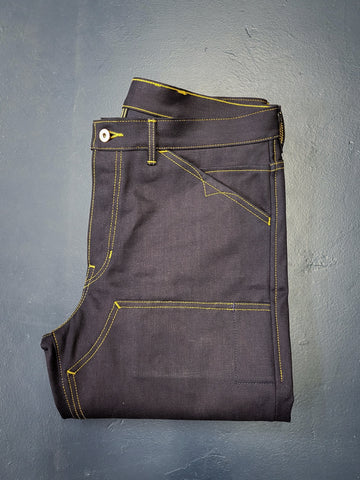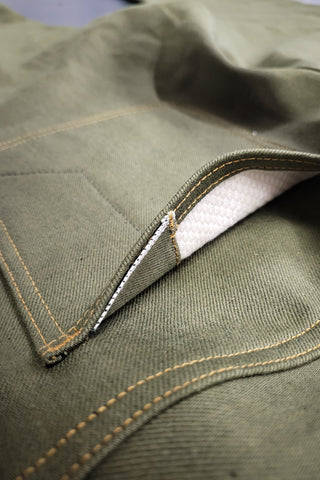Work Pants
This blog post focuses on design features for a newly releasing product. It is the second in a series of three blog posts focusing on design details for each of three new products coming to market in Q1 2022 time frame.
Work Pants
Work Pants are designed to accommodate physical movement of all types. The product goal is to adhere to heritage design features, but ensure they are durable and can be used for physical activities and work. The core fabrics in the previous Casual Denim Pants blog post and the Work Pants use the exact same core fabrics. A key consideration is using mid-weight fabric. While the trend in heritage denim is towards heavyweight fabrics, if you are using pants for physical work, it certainly is easier if the fabric is middle weight which bends and creases more easily than heavy weight fabric (17+ ounces) and especially very heavyweight (21+ ounces) fabrics. Even after those heavy weight fabrics are broken in, they do not bend as easily as middle and lightweight fabrics. With this in mind, the core fabrics are as follows:
- Vidalia Mills USA manufactured indigo/natural 14 ounce denim
- Vidalia Mills USA manufactured black/black 14 ounce denim
- Candiani Mills Italian manufactured indigo/indigo 14 ounce denim
- Nihon Menpu Mills Japanese manufactured green/green 14 ounce denim
- Custom – there will be many other fabrics available, but they will be custom small batch runs
Besides a nice range of core denim options, here are the design features for the pants. The front and back pockets are designed the exact same way as the Casual Denim Pants. That info* has been placed at the bottom of this post in case you already read that in the previous article.
Front Panels
The Work Pants use double front panels that double the thickness of the pants where they have the most friction during most physical work type activities. The panels are the same fabric as the overall pants fabric. This allows for durability in high wear spots, but maximum range of motion and movability in all other places on the Work Pants so you can still move around easily in the pants.

Belt Loops and Patch
The design uses six belt loops evenly spaced around the waist. The middle back has the leather patch instead of in a traditional jean location to the right on the back of the pants. This patch is placed in the middle with sewing on top and bottom for belt pass through ability which allows the patch to be used as an extra durable “belt loop”. It is placed in the middle of the back so it is in the place that has the most stress on the belt loops typically and spreads out the stress across double sewn leather versus on a narrow belt loop which will maximize durability. Unlike the Casual Denim Pants, the Work Pants use a contrasting color leather patch similar to traditional jean and dungaree work wear clothing.


Sewing, Thread and Miscellaneous Details
Contrasting stitching is used throughout the pants. The thread and hardware are all USA sourced. And finally, the pants are meant to be worn often and worn hard for any kind of physical activity. With this in mind, the pants have free lifetime repairs available for customers. Wear em hard!!! The pants are a design and crafting partnership between Rugged Workwear – Heritage Quality Goods in Marietta, Georgia and Skinner American Goods in Tallahassee, Florida.

Thanks for reading and please do not hesitate to reach out if you have design questions.
Utility Pockets
There are several subtle hidden utility pockets in the Work Pants. Tonal stitching is used for these pockets. And they are located in each front panel and also the rear pocket. When working you can never have enough pockets in my experience.



*Front Pockets
The front pockets focus on function over form. However, they do look great playing the part of functional pockets. First, the pocket bags are made from 12 ounce natural sashiko fabric. This is a very durable fabric, and it also ages quite beautifully with heavy dye transfer from the denim used in the pants. Besides the aging characteristics, the bags are large and deep so you definitely can use these to warm your hands on a cold day and also to store a lot of stuff. One of the things I like about the front main pocket is the ability to store larger phones without the phone gouging your upper hip/abdomen when you sit down which happens often with traditional jean pockets with short pocket bags. The other design feature is slanted pocket openings for very easy access and usability. One thing I hate about many jeans is when the front pocket openings are restricting and you can barely get your hands in the pockets (if you can at all). Also creating difficulty doing very simple things like putting your keys in your pocket and taking your keys out of your pocket. That is not an issue in these pants. Very usable. The secondary front pockets are made with the same fabric as the overall pants. They are sort of like a coin pocket, but much larger and usable for many things besides a quarter or a nickel or a penny. The pockets are 6 inches deep and wide so they are nearly as large as many traditional jean pockets. And easy to get things into and out of. Making for more functional front pockets should you need them. Four usable pockets instead of no usable front pockets on many jeans nowadays. A final design detail is the pointed top pocket stitch which on the casual denim pants is very subtle, with tonal stitching. But interesting when you examine the details closely. And will make for an interesting aging feature while the pants fade.


*Back Pockets
These are designed like traditional worker “French pockets” on work pants, but look very similarly to traditional back jean pockets, but with rounded instead of square edges. Back pockets are fully lined with the 12 ounce natural sashiko which is used for the main front pocket bags. This ensures that the back pockets have maximum durability so holes from wallets and phones do not develop quickly as is typical with traditional jeans using unlined rear pockets. The pointed stitch detail is also used on the top of the rear pockets instead of arcuates. Like the front pockets, the rear pockets are larger and more usable from a storage perspective.

